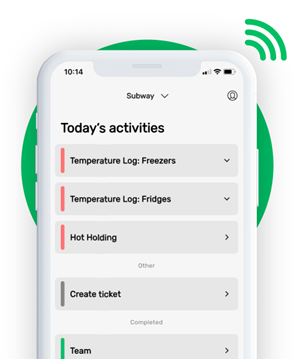FREE ALLERGEN CHART FOR FOOD SAFETY
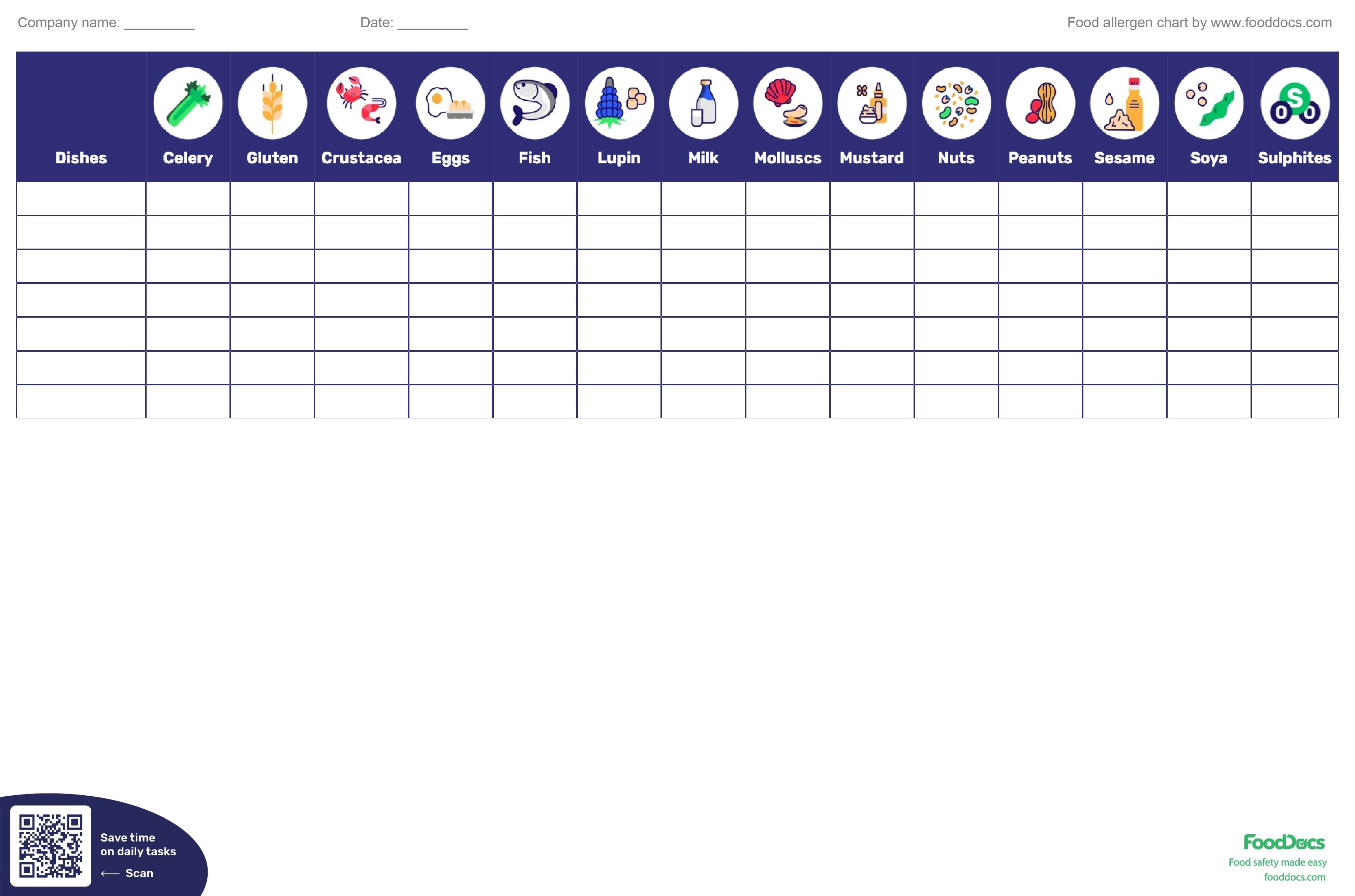

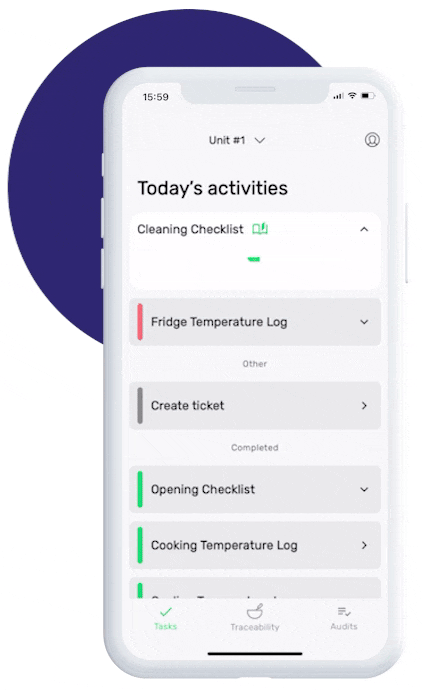
This is how our Digital Food Safety platform saves 20% of your time on daily tasks:
- Get upcoming task notifications
- Add data into the app
- Check the status of tasks in real-time

When food safety was still handled on paper, I typically spent a couple of hours per day getting the papers and going around checking or completing tasks… Now I can sit down and it's just all there in one place. It takes me 5-10 minutes.
Ruth B.
Store Manager
| Dishes | |||||||||||||||
|---|---|---|---|---|---|---|---|---|---|---|---|---|---|---|---|
| Dish | |
|---|---|
It only takes a handful of allergens to cause most life-threatening reactions to food allergies. Food business teams and customers with food allergies can use food allergen charts as references for foods with allergenic ingredients.
Depending on the formulation of the food in question, individual dishes can have more than one food allergen.
Key takeaways
- Food allergy is the body's reaction to a particular allergen which can manifest through mild or life-threatening allergy symptoms.
- Food allergens require a comprehensive management plan to ensure that cross-contact with non-allergenic foods will be prevented.
- Food businesses are required to inform their customers, either through product labeling, verbal cues, or visual aids, about the potentially present food allergens in their products.
- A comprehensive allergen management plan includes food safety training, customer communication, visual tools, accurate labeling, monitoring, and regular audits.
- The nine most common food allergens in the US include eggs, milk, fish, crustaceans, wheat, soy, tree nuts, peanuts, and sesame.
- The fourteen most common food allergens in the UK include cereals with gluten, crustaceans, eggs, fish, peanuts, soybeans, milk, nuts, celery, mustard, sesame seeds, sulphur dioxide, sulphites (food additives), lupin, and mollusks.
- FoodDocs' intuitive Food Safety Management System allows food business operators to automatically get an intuitive Food Allergen Chart and other smart solutions for proper food allergen management.
How to use a food allergy chart
Here is a clear 6-step guide on how to use the FoodDocs Food Allergen Chart:
- Familiarize the chart. The food allergen chart, also known as the food allergy list template, consists of columns and rows to determine which food allergen is in a particular product.
- Identify the major allergens. The template has pre-set allergens based on the user's location.
- List dishes with allergenic ingredients. At the leftmost column, list all dishes that may potentially have major allergens.
- Click on the present allergen/s. More than one food allergen can be selected.
- Add more rows. If needed, users can add more rows to accommodate more dishes.
- Download the chart. Enter a valid email address and click on "Download." The generated allergy chart will automatically be sent to the downloaded folder.
Pin the chart on the central kitchen wall as a reminder for staff. A food allergy list will remind the team which foods contain high-risk food ingredients and which ones must be well separated to avoid cross-contamination and cross-contact.
Upgrade food allergy management practices in every food business unit by using our smart Food Safety Management System. Get smart solutions for distributing allergen information and training employees in food safety and proper allergen handling.
Allergy Matrix Template: A Critical Tool for Allergen Control in Food Business
One of the most vital regulations by food safety agencies is the declaration of food allergens in products. Food allergens are common compounds in products that can cause adverse effects in certain people with sensitivities.
Allergic reactions to food are common all over the world. This makes people with food allergies susceptible to allergic reactions when dining in food establishments or purchasing food products. As such, every food business is responsible for protecting consumers from the potential risks of food allergens by providing adequate information.
Food businesses can significantly manage allergenic ingredients by using a Food Allergen Chart or an Allergen/Allergy Matrix.
To help every food safety team and food business operator remember all the necessary information for allergens, download our food allergen chart template or keep reading to learn more.
WHAT WE'LL COVER:
- What is a food allergy?
- Food allergy statistics in different countries
- What are the best strategies for allergen management in any food business?
- What is the importance of managing dishes and their allergen content?
- What are the risks associated with food allergens?
- What is a food allergen chart or an allergen matrix?
- What are labeling laws related to allergens?
- How to get a comprehensive and intuitive food allergen chart?
- Frequently Asked Questions (FAQs)
What is a food allergy?
A food allergy is the immune system's response to specific foods with allergenic proteins.
In cases of food allergy reactions, the immune system mistakes a distinct protein from allergens as a foreign, harmful component and aggressively attacks it.
Food allergic reactions are mostly mild, but for some people, they can cause adverse reactions or even life-threatening responses for people with weak immune systems. Reactions can range from mild gastrointestinal discomfort and itching to difficulty in breathing, which can lead to death due to asphyxia or lack of oxygen.
Food businesses have a crucial responsibility to ensure the safety and well-being of customers with food allergies. They should be knowledgeable about common allergens, clearly label the list of ingredients, prevent cross-contact, and provide accurate allergen information.

What are the common symptoms of food allergy?
Food allergies can manifest in various symptoms, which may differ in severity from person to person.
From skin reactions to gastrointestinal issues, understanding the common symptoms of food allergies is crucial for prompt recognition and appropriate management.
Below are the most common symptoms of food allergy that food businesses should look out for:
- Tingling or itching in the mouth
- Hives, itchy sensation, or eczema
- Swelling of the lips, face, tongue, throat, or other parts of the body,
- Wheezing, nasal congestion, shortness of breath, or worst, anaphylaxis
- Abdominal pain, diarrhea, nausea, or vomiting
- Dizziness, lightheadedness, or fainting
If a food allergy is suspected, it's always important to speak with a doctor about it.
Safety precautions can be applied to minimize allergic responses or completely prevent them from occurring for some time. On the food manufacturer's side, the key to keeping food safety a priority is to properly identify and duly declare any food allergens in their products.
On the other hand, it is a consumer's responsibility to know whether they are allergic to certain food articles or not. With such knowledge, the customer can then be more cautious of the ingredients in the foods served in the establishment.
Food allergy statistics in different countries
Researchers have established from food allergy reports that the most commonly fatal food allergy reactions occur outside the home. This fact means that most allergic reactions are likely to occur in food businesses.
The rate of food allergic reaction cases varies from one country to another. A study on how different countries worldwide provide food allergy information proved that the UK has the highest number of children with proven food allergies.
In addition, the most common food allergens also vary from country to country. The same study revealed that milk allergy is more common in the UK, the US, Australia, and a large part of Asia, whereas it is very uncommon in Greece and Italy.
This fact can indicate that more people have allergies in one country or that some countries may have a deeper understanding of food allergies than others.
Food allergy has been reported to occur to at least 220-250 million people worldwide and affects their everyday lives. The effects of allergic reactions to food can significantly slow down productivity and even lead to serious health issues when left untreated. This is why it is legally required for businesses to provide all of the necessary information to customers about food allergens.
In this section, we list some of the most useful statistics about food allergies in the US and the UK.
Food allergies in the US
To date, approximately 32 million Americans have at least one identified food allergy. Of this estimate, approximately 5.6 million are children under the age of 18.
The nine food ingredients recognized as major allergens contribute to the majority of serious food allergy reactions in the country. The major food allergens are responsible for at least 2,000 hospitalizations and 150 deaths yearly due to anaphylaxis or severe food allergic reactions.
Most recent studies showed that the majority of the American population is allergic to shellfish and milk the most.
There is currently no cure for food allergies. To prepare for unforeseen circumstances, the majority of states in the US passed food laws that permit public establishments to stock epinephrine pens, an allergy medication.

Food allergies in the UK
In the UK, around 1-10% of the total adult and children population have at least one diagnosed food allergy.
The most common food allergy in the UK includes allergies to peanuts, milk, and eggs. These foods can easily be found in any complex food, such as chocolates, baby food, ice creams, feeding formula, and others.
Research in the UK showed that approximately 2-3 babies out of a hundred are affected by allergy to milk. Another common food allergy particular to the UK is Celiac disease, an autoimmune disorder triggered by gluten consumption. Approximately 1% of the entire UK population has this condition.
What are the best strategies for allergen management in any food business?
Effective allergen management contributes to the strict implementation of high food safety standards for protecting customers from unwanted allergic reactions.
Build an effective and comprehensive food allergen management plan by incorporating the following strategies:
- Food handler training. Orient and properly train food handlers about the common allergens that need to be monitored in the food business and how to handle them properly. Enroll them in essential food safety training courses. Food handlers must also be aware of the symptoms of allergic reactions and the necessary actions to take in case of its occurrence.
- Supplier control. Establish strict protocols for suppliers and communicate allergen information. All suppliers must present any potential presence of allergens from products they supply to minimize the risk of cross-contact.
- Consistent monitoring. Regularly check ingredients, recipes, and processes to identify any potential sources of cross-contact or allergen exposure. Establish comprehensive monitoring procedures for allergen control.
- Accurate labeling. Provide clear and accurate allergen labeling on product packaging and menus, ensuring customers can easily identify allergenic ingredients.
- Allergen management. Implement segregation practices, separate storage, dedicated equipment, and cleaning procedures to minimize the risk of cross-contamination during food preparation and handling. Read more about using color-coded chopping boards in our detailed article here.
- Communication with customers. Encourage customers to inform staff about their allergies and provide detailed allergen information upon request. Visible notes and cues on menus or walls can help prompt customers about the risk of food allergies. Additionally, add a general advisory statement to the menu, such as, "Customers can ask for advice about food allergens from the staff."
- Regular audits. Conduct internal audits and food safety inspections to assess the effectiveness of allergen management procedures, identify areas for improvement, and ensure compliance with food safety laws.
By implementing these strategies, food businesses can prioritize allergen management, reduce the risk of allergic reactions, and provide a safer dining experience for customers with food allergies or hypersensitivity reactions.
Minimize the risk of food allergies by using our intuitive Food Safety Management System. Our smart software features task notifications with instructions that can be used to train employees in handling allergens and notifying customers.
Why is it essential to manage dishes and their allergen content?
One of the best ways to manage dishes and their allergen content is to list them down using an allergen matrix. An updated document and list of dishes with associated food allergens provide a clear reference for the whole team.
By implementing effective strategies for allergen management, businesses can achieve the following:
- Customer safety. By effectively managing identified allergens in dishes, businesses can help prevent allergic reactions and potentially life-threatening situations.
- Clear communication. Clear communication about allergen content builds trust and confidence in the business, enabling customers to dine with peace of mind.
- Accurate meal planning. Proper allergen management enables businesses to plan their menus to cater to the customer's dietary specifications. This includes offering allergen-free alternatives or modifications to accommodate individual requirements, enhancing the overall dining experience.
- Staff training. Educating employees about allergens, cross-contamination prevention, and proper handling techniques enables them to address customer inquiries, handle allergenic ingredients safely, and provide accurate allergen information.
- Legal food safety compliance. By managing dishes and their allergen content, businesses can meet legal requirements, avoiding potential penalties, legal liabilities, and damage to their reputation.
Overall, food businesses are required to manage their dishes with allergens as part of their approach to food safety. This control is part of their commitment to serving customers with safe and quality foods.
Guide food handlers on which food allergens to look out for by using our Downloadable Food Allergens Poster.
What are the risks associated with food allergens?
Handling food allergens may be unavoidable for food businesses. Food allergens are very common foods that are used in everyday cooking. As such, allergen awareness for every food handler is critical.
Here are the most notable risks associated with food allergens:
- Allergic reaction. The most immediate and serious risk of food allergies is the potential for allergic reactions. People with food allergies can suffer mild to life-threatening reactions as a result of exposure to allergens.
- Cross-contact. Cross contact occurs when an allergenic food comes into contact with a non-allergenic food, utensils, surfaces, or equipment. Even small traces of allergens can trigger allergic reactions in sensitive individuals. Cross-contact is different from cross-contamination.
- Legal liability. Non-compliance with allergen labeling requirements, misrepresentation of allergen information, or negligence in preventing cross-contact can result in lawsuits, fines, and damage to a business's reputation. These are all serious food safety offences. Undeclared allergens are one of the leading causes of food recalls in the US.
- Loss of customer confidence. Failure to meet customer needs can result in customers seeking alternatives, negatively impacting the business's reputation and customer loyalty.
Understanding these risks emphasizes the importance of proper allergen management in the food industry. By implementing appropriate measures, businesses can ensure the safety of customers, prevent legal liabilities, and maintain the trust and confidence of individuals with food allergies.
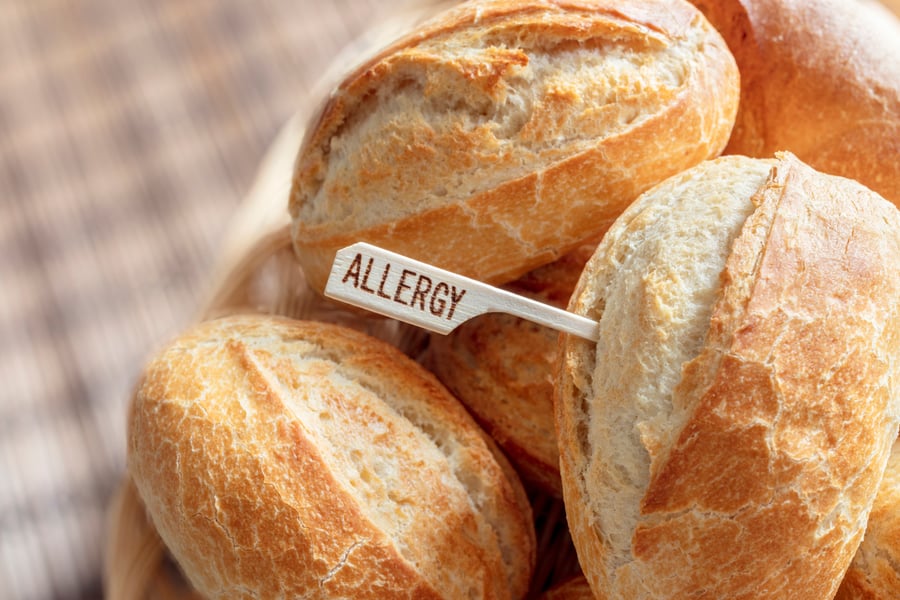
What is a food allergen chart or an allergen matrix?
A food allergen chart is a useful allergen control tool that contains a list of the products in a food business containing food allergens.
A flexible food allergy chart template allows a food handler to see at a glance which dishes on the menu contain any major allergen risk. It's a record where all the menus and allergens in foods are listed, so food safety teams get a simple overview of all the necessary information.
The food allergen chart is especially useful for food processing facilities that produce foods containing food allergens and can serve as an allergen control checklist.
A food allergen chart is not legally required, but it can make allergen control easier when informing customers, especially people with food allergies. It can be challenging for the food safety team to keep in mind all food allergens when the menu is changing, particularly when there are seasonal employees.
Who needs a printable allergen sheet template?
Generally speaking, anyone who manufactures, prepares, serves, handles, or packs food is liable to declare food allergens in their products to protect their customers with allergies. As such, all food manufacturing businesses and services will benefit from using a Food Allergen Sheet template or a Food Allergy Chart.
The occurrence of public health issues due to consuming foods from a business with undeclared food allergens can result in serious legal problems.
Food agencies enforce the requirement for all food facilities, including grocery stores, delicatessens, bakeries, cafeterias, and restaurants, to follow the food allergen code.
The range of food products that require labeling includes:
- Conventional foods
- Packaged foods
- Medical foods (for tube feedings and related cases)
- Infant formula
- Vitamins and dietary supplements
Proper food allergen declaration regulations apply to any food sold in packages labeled as "for individual sale." Included in the list of businesses required to declare food allergens are those that produce flavors, spices, and coloring agents.
Essentially, all food businesses required to declare food allergens in their products would benefit from a food allergen chart. Use the chart in food business operation facilities and incorporate it as a vital part of the food safety plan.
When should you review and revise an allergy chart?
Updating the food allergy chart can be a bit troublesome, especially for food service establishments that change their menus seasonally or even every day. There will always be certain times when the food allergy chart and allergen management plan must be revised.
Update the food allergy chart in the event of the following circumstances:
- Menu and ingredient changes. Every time the menu changes, check all the ingredients and fill the food allergy chart with a new menu item.
- Seasonal offerings. Some businesses offer seasonal products. In this case, customers must be duly informed if the seasonal product contains allergens.
- Supplier change. Every time a new supplier is used, check all the ordered ingredients, ask for product specifications when needed, and update the food allergy chart according to the menu.
- Regulatory changes. Food safety agencies often update possible major allergens, such as the most recent addition to the major food allergens list in the US, which is sesame. In case of changes, always update the food allergy chart.
- Customer reviews. There are more than 170 foods that can cause allergic reactions in humans. The commonly emphasized list of food allergens only contains the major contributors to allergic reactions. In case a customer proactively mentions having allergies to a particular food, take note and incorporate it in the food allergy chart.
Using our flexible food allergen chart template, food businesses can edit, customize, download, and print it as needed. Updating the food allergen chart will always be easy as this chart template is free.
How to effectively use an allergy sheet in a food business?
The use of an allergy sheet, also known as the food allergy chart, in a food business can lead to a more organized and planned operation. Although it is a very simple tool, using the allergy sheet can save food businesses from serious food safety issues. It also increases needed awareness among food handlers.
Get the most out of the allergy sheet by following these steps:
- Gather accurate information. Maintain a centralized database or system to organize this information, making it easily accessible when needed. This step refers to both the existing major allergens in the food business location and comprehensive information about the ingredients being used in the establishment.
- Complete the allergy sheet. Translate all of the gathered information into the allergy sheet by ensuring that all dishes are listed. Update the allergy sheet whenever changes are made to the recipes. Double-check the list as always.
- Train staff. It is not enough that the allergen sheet is posted on walls. Kitchen staff members must be familiar with how to use it and how to respond to food allergen concerns or emergencies.
- Display allergen information. Make sure that the information and food allergen warning precautions are present in the entire establishment. That includes the physical and online menus, information boards, websites, and poster walls. Use the clearest food allergy notice.
- Regular review for improvement. This step is very important. The food allergy document is not an absolute tool, and it requires regular reviewing to update the information on additional food allergens from food safety agencies and the food establishment.
Updating the allergen sheet is not a problem with our Free Downloadable Food Allergy Chart. Easily update information and print out a new chart for the food business.
The only downside to this essential resource is the need to retype everything again when there are updates to be applied. For this and more, use our intuitive solutions from our smart Food Safety Management System.
Create a comprehensive database of recipes with highlights on allergenic ingredients and get an automatically generated food allergen chart or allergen matrix with just a few clicks!
What are labeling laws related to allergens?
Different locations may have different food safety regulations on declaring food allergens. These laws aim to protect individuals with food allergies by ensuring that allergens are identified on product labels. Compliance with these laws is crucial for food businesses to provide accurate information and promote consumer safety.
What are allergen labeling laws in the US?
The US allergen labeling procedures are regulated by the Food Allergen Labeling and Consumer Protection Act of 2004 (FALCPA). The law identifies and communicates to the food industry the major food allergens that cause the majority of food allergy cases in the country.
The law requires that all food labels regulated by the FDA should indicate which ingredient is a source or derivative of one of the major food allergens. The FALCPA also regulates how the allergens should be stated on the label.
The jurisdiction of the FDA does not include chicken, poultry products, and meat. This means that products under the USDA FSIS jurisdiction are not under the FALCPA. Despite this, the FSIS highly encourages the use of similar allergen statements to indicate the presence of food allergens in meat and poultry products.
On the other hand, food handlers responsible for the production of fresh produce such as fruits and vegetables are not required to declare food allergens. Similarly, refined oil manufacturers are not required as well.
What are allergen labeling laws in the UK?
For any food businesses in the manufacturing and catering industry that are selling products containing allergens, it is required by Natasha's Law, in addition to Regulation (EU) No 1169/2011, to inform customers about them. The food legislation applies to restaurants, fast-food trucks, takeaways, shops, bakeries, etc.
Food allergen labeling regulations, as declared by the Food Standards Agency in the UK, demand all food establishments to declare food allergens in their foods. This includes providing allergen information to consumers and handling food allergens effectively during preparation.
Foods and directives that are under this jurisdiction include:
- Pre-packed foods. Products that are packed before being sold, which may be fully or partly enclosed. This term refers to products that must be opened before consumption and are ready for sale. Complete food labeling must be placed in a visible area before putting the product on sale.
- Non-prepacked (loose) foods. Products that do not have any packaging, such as baked goods and ala carte dishes. In this situation, the menu or product list must have the necessary food allergen information. In case the food allergen menu matrix is not available, staff must disclose information to consumers about any potential allergens in their non-prepacked (loose) food products.
- Prepacked for direct sale. Food products under this category are packed in the same location where they are sold. Examples of prepacked foods for direct sale include sandwiches or burgers from a fast-food chain.
A complete ingredient list and declaration of allergenic ingredients must be emphasized. Non-compliance with food labeling laws is considered a criminal offence and can affect the reputation of the food business. In addition, offences also entail fines for damages.

Get a comprehensive and intuitive food allergen chart with FoodDocs
A food business' approach to managing allergens speaks much about how they take food safety seriously. Food allergen-related issues can create a large problem for food businesses and can be very damaging to the company brand.
At FoodDocs, our team of food safety specialists developed digital smart solutions that can provide a comprehensive allergen management plan and more in approximately 15 minutes.
Food Allergy Chart
Guide food safety teams on which products contain food allergens through the automatically generated Food Allergy Chart from our software. The chart is generated based on the provided information after uploading recipes and product specifications.

When setting up our smart software, users can efficiently mass-upload all digital recipes into our system. Our smart system recognizes priority food allergens for a food business, highlights all present allergens on the specification page, and assembles the information in a detailed Food Allergy Chart.
With this smart solution, the team can ensure that all allergenic dishes are included in the chart and it stays updated every time you upload new recipes.
Customize the chart at any convenient time to stay updated and communicate the information to the team seamlessly. All encoded information will stay in the database and will only require regular updates from the team.
Unlike using the free templates, you do not need to retype all information and manually review the chart, as our system does these tasks for you.
Task notifications with instructions
Save time from training the food safety management team individually by using our smart solutions. Use our detailed step-by-step instructions attached to each monitoring sheet or checklist that shows clear guides on how to handle allergens and keep the establishment free from cross-contact.
Additionally, make sure that the team will never forget any of the everyday operations needed for managing allergens with our smart notification system. Through our Food Safety App, the system will send intuitive alerts to assigned food handlers, reminding them of important food operations, such as separating allergenic foods from non-allergenic products.
Real-time overview
Make sure that all food safety tasks related to handling allergens are done on time and correctly. Food safety managers can get a real-time dashboard from the desktop application and visual cues on the Food Safety App that shows the status of every task.
Immediately identify tasks that need more attention and address them right away. Save even more time from manually reviewing all food allergen controls onsite by using our real-time dashboard.
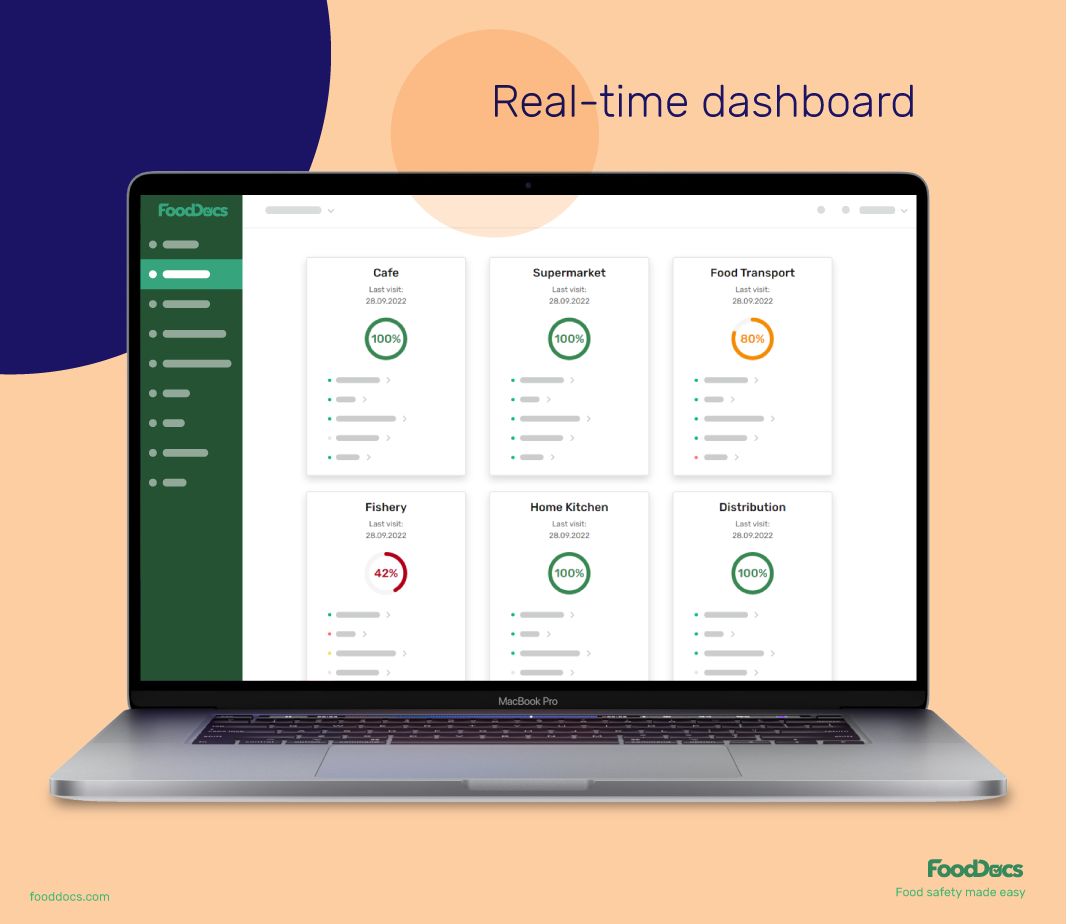
Demonstrate your dedication to public safety and food allergy awareness with our intelligent software. Not only will it enhance your company's compliance with food safety regulations, but it will also contribute to improved overall performance.
This all-in-one food safety software establishes a seamless connection between onboarding procedures and the actual execution of tasks, effectively minimizing food safety concerns, including incidents related to food allergies.
Join our list of 30,000 customers enjoying digital food safety compliance and start your free 14-day trial today!
Frequently Asked Questions (FAQs)
Here are some of the most common questions about the food allergy chart or allergy matrix to help you understand the topic better.
What is a food allergen sheet?
A food allergen sheet is a document that lists the dishes or food items offered by a food business along with the allergenic ingredients or allergens present in each product.
What is an allergen list template in the US?
In the US, an allergen list template is a standardized format or template that businesses can use to create a comprehensive list of allergens present in their food products. An allergen list template is often also referred to as a food allergy chart, an allergen sheet template, or sometimes a food allergy matrix.
What should be done with allergen information when a product does not have an ingredient list?
When a product does not have an ingredient list, it is essential to seek out allergen information from the manufacturer or supplier. This information should be obtained and documented separately, ensuring that it is readily available to address customer inquiries or concerns about allergenic ingredients. In both the US and the UK, food businesses are legally required to declare allergens in their products.
What is an allergy matrix in the UK?
An allergy matrix in the UK is a tool used to assess and manage allergenic ingredients in food products. It typically involves a grid or table format that cross-references ingredients with potential allergens, allowing businesses to identify and communicate the presence of allergens in their food offerings.
Which foods cause allergic reactions?
There are at least 170 known food ingredients that can cause allergic reactions. The most common foods known to cause allergic reactions are often referred to as the "big nine allergens" in the US. These include milk, eggs, peanuts, tree nuts, fish, shellfish, soy, wheat, and sesame. In the UK, 14 main allergens are recognized: cereals containing gluten, crustaceans, eggs, fish, peanuts, soybeans, milk, nuts, celery, mustard, sesame seeds, sulphur dioxide, sulphites, lupin, and mollusks.
